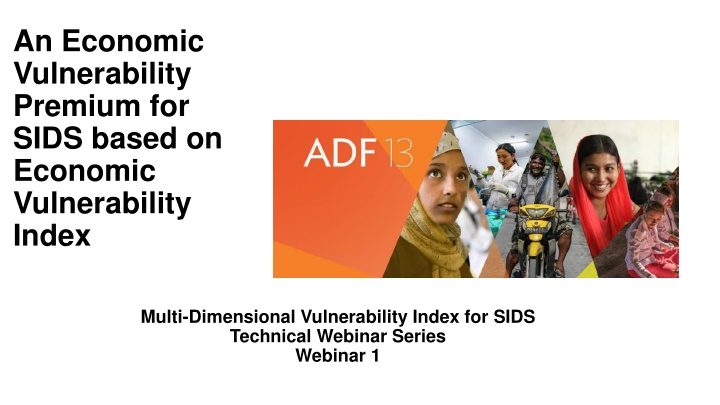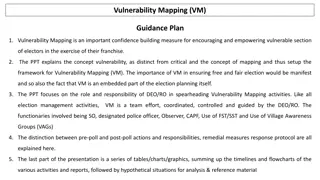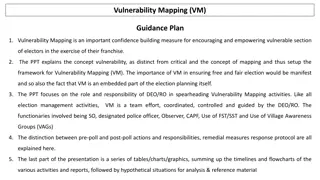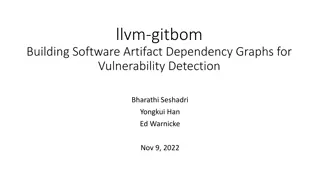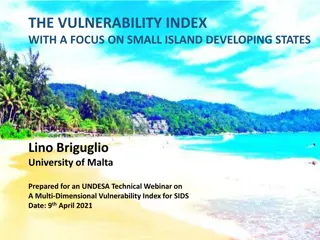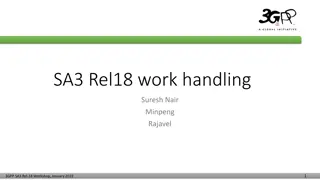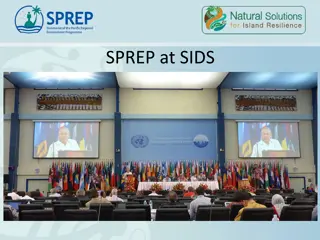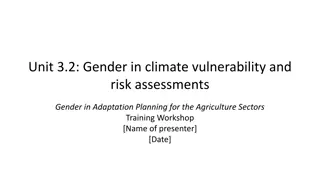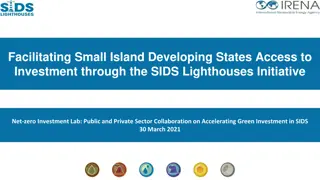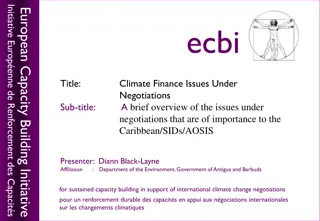Economic Vulnerability Premium for SIDS - Webinar Insights
Presentation outlines applying Economic Vulnerability Index (EVI) for an Economic Vulnerability Premium in Small Island Developing States (SIDS) during ADF 13 cycle. Details ADF grants availability, grant allocation framework, performance-based allocation system, and modifications needed for SIDS.
Download Presentation

Please find below an Image/Link to download the presentation.
The content on the website is provided AS IS for your information and personal use only. It may not be sold, licensed, or shared on other websites without obtaining consent from the author.If you encounter any issues during the download, it is possible that the publisher has removed the file from their server.
You are allowed to download the files provided on this website for personal or commercial use, subject to the condition that they are used lawfully. All files are the property of their respective owners.
The content on the website is provided AS IS for your information and personal use only. It may not be sold, licensed, or shared on other websites without obtaining consent from the author.
E N D
Presentation Transcript
An Economic Vulnerability Premium for SIDS based on Economic Vulnerability Index Multi-Dimensional Vulnerability Index for SIDS Technical Webinar Series Webinar 1
Objective Objective The objective of the presentation is to outline the application of the Economic Vulnerability Index (EVI) to create an Economic Vulnerability Premium for SIDS during the ADF 13 cycle.
ADF Grants for Which Countries? Group B Group Aa Access to COL and regular OCR Access to ADF grants and COL Kyrgyz Republic Solomon Islands Vanuatu Access to ADF Grants only Access to COL Afghanistan Micronesia, Federated States of Kiribati Maldives Marshall Islands Nauru Samoa Tajikistan Tonga Tuvalu Bhutan Cambodia Lao PDR Myanmar Nepal Bangladesh Mongolia Pakistan Palau Papua New Guinea Timor-Leste Uzbekistan = fragile and conflict-affected situation = small island developing states a Country classification expected in 2021, subject to confirmation of debt sustainability assessments. Country classification can change during an ADF cycle.
ADF 13 GRANT ALLOCATION FRAMEWORK AFG = Afghanistan, RCI = regional and cooperation integration, RHS= regional health security, RPGs = regional public goods, SDG =Sustainable Development Goal, SIDS = small island developing states. Source: Asian Development Bank.
Performance Performance- -based Allocation System based Allocation System Performance-based allocation (PBA) system is widely used by MDBs and favored by donors of concessional finance due to clarity and transparency of the formula-based approach and reliance on a limited number of key development-related variables, and its reward of improvements in institutional capacity. PBA system is core of ADB s resource allocation framework for concessional resources. PBA formula is a weighted geometric function of the composite country performance rating, per capita income, and population.
Limitations of PBA system Limitations of PBA system PBAs for SIDS are generally very small mainly due to their small population size, and they are not sufficient to meet the country needs for key development programs. PBA system to be modified to increase allocations for SIDS, to ensure sufficient financing, and build resilience and address the causes of vulnerability. Vulnerability and fragility indices can be integrated in ADF resource allocation framework to provide a tailored supplementary allocation for eligible SIDS
Fragility Indices Fragility Indices Major constraint of using vulnerability and fragility indices as part of the ADF resource allocation framework is limited coverage of ADB developing member countries Available fragility indices do not sufficiently cover ADF grant- eligible SIDS Fragility indices also tend to reflect a wide range of indicators related to political, economic and social aspects as well as experts qualitative analyses in some cases, which increases the complexity of their methodologies
Vulnerability Indices Vulnerability Indices Among three vulnerability indices [Economic Vulnerability Index (EVI), Climate Risk Index and World Risk Index] only EVI covers all ADF grant-eligible countries Climate Risk Index country ranking is narrowly focused on disasters and tends to change drastically according to whether actual disasters occurred each year The World Risk Index consists of 27 indicators which makes calculation complex and prone to the issue of data collection The EVI is considered to be the most suitable vulnerability index for use in ADF resource allocation framework, based on country coverage, data availability, simplicity and comprehensiveness. EVI covers all 10 ADF grant-eligible SIDS, and measures the structural vulnerability of countries to economic and environmental shocks EVI scores are relatively stable as some of the parameters (e.g., remoteness from world market and share of population in low elevated costal zones) do not significantly change over time. This means that update of scores does not cause significant fluctuations in resource allocation from one ADF cycle to the other.
Two Options to A Two Options to Amend the Resource mend the Resource Allocation Framework Allocation Framework Integrating vulnerability indices in the PBA formula Determining the size of a premium for SIDS based on vulnerability indices outside the PBA system
I Integrating Vulnerability ntegrating Vulnerability I Indices in the PBA Formula ndices in the PBA Formula (Tentative Results) (Tentative Results) Integration of vulnerability indices into the PBA formula by itself (i) does not ensure sufficient resource allocations to all ADF grant-eligible SIDS; (ii) creates a wide range of country allocations among SIDS; and (iii) cannot replace the special support to Afghanistan. In summary, integrating vulnerability indices in the PBA formula does not generate adequate resource allocations for SIDS.
Economic Vulnerability Premium Introducing a premium outside the PBA system for ADF grant eligible SIDS to provide tailored support based on the degree of vulnerability of countries. Based on the Economic Vulnerability Index (EVI). SIDS are divided into groups based on their EVI scores. SIDS are allocated amount for economic vulnerability premium (EVP) based on EVI classification. The allocation of EVP is limited to ADF-grant eligible SIDS because other ADF-grant eligible countries benefit from much larger PBAs. The premium amount will not change during the ADF 13 cycle to ensure predictability.
Economic Vulnerability Premium for ADF Grant-Eligible SIDS Based on the Economic Vulnerability Index (EVI) Range of $40 55 million per cycle Premium per cycle ($ million) EVI Score Country 70-80 (more vulnerable) Kiribati 55 Marshall Islands 50 60-70 Federated States of Micronesia, Maldives, Nauru, Solomon Islands, Tonga and Tuvalu 45 50-60 40-50 (less vulnerable) Samoa and Vanuatu 40 1 2 21
Conclusions Conclusions Introduction of EVP ensures more adequate allocations for ADF grant-eligible SIDS to build resilience and address the causes of vulnerability. Indicative ADF grant country allocations for SIDS during ADF 13 total $576 million or about 28% of total country allocations and are about 46% higher than provided under ADF 12. EVI is considered to be the most suitable vulnerability index for use in ADF concessional resource allocation framework, based on country coverage, data availability, simplicity and comprehensiveness.
Thank you 19
